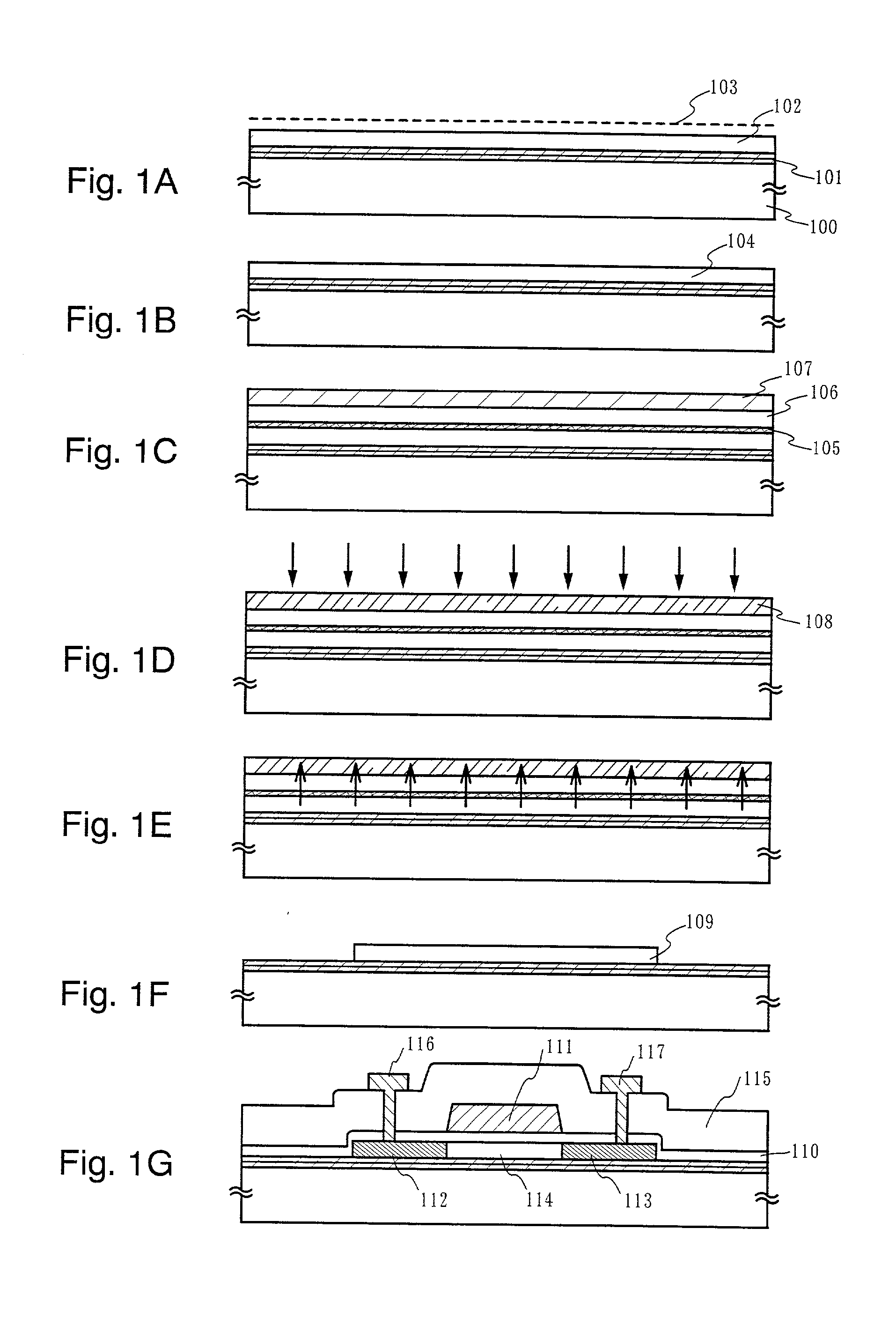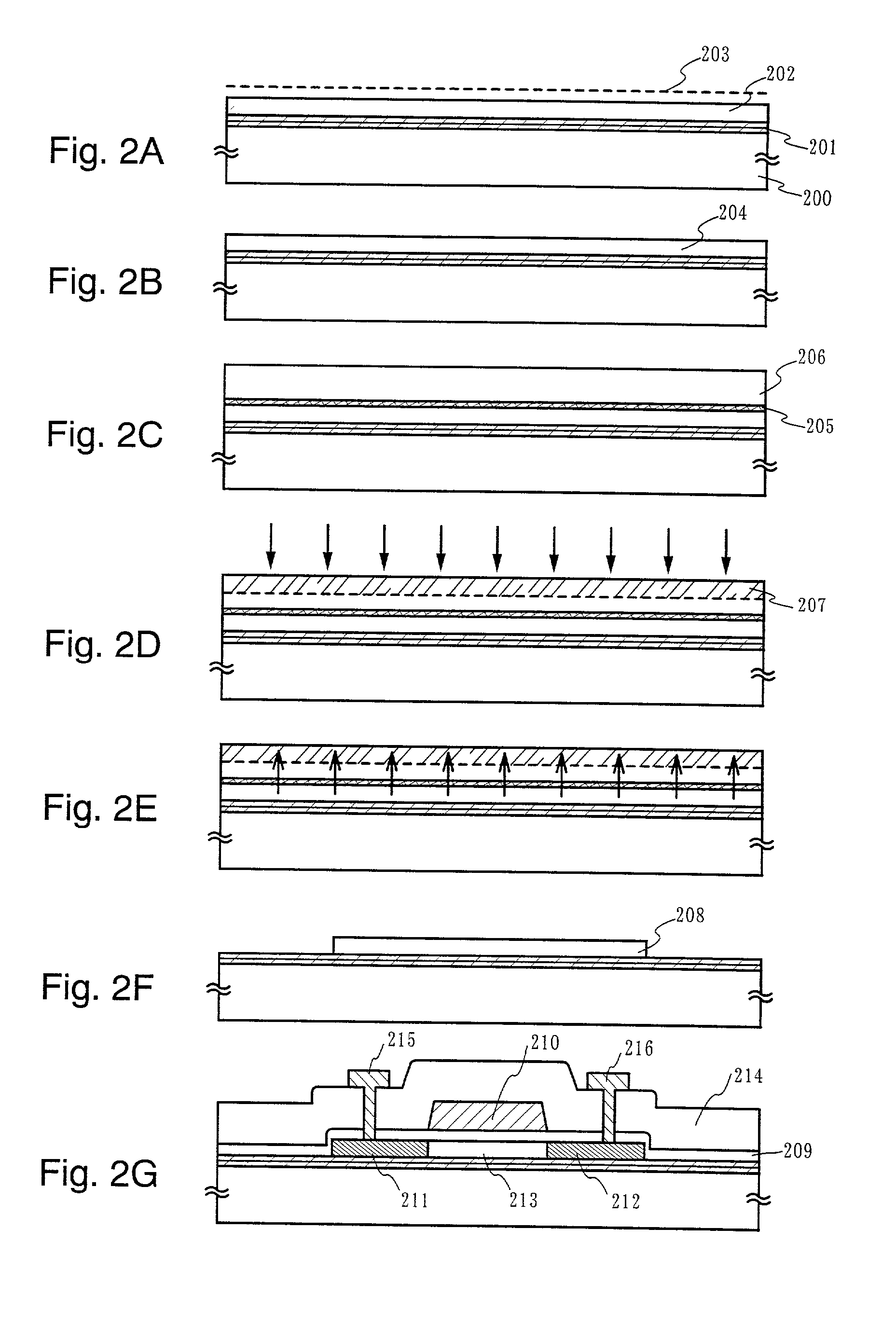Method of manufacturing a semiconductor device
a manufacturing method and semiconductor technology, applied in semiconductor devices, instruments, optics, etc., can solve the problems of inability to control the crystal orientation, limitations in the properties of tft, and the possibility of increasing the crystal orientation arrangement to become more unidirectional
- Summary
- Abstract
- Description
- Claims
- Application Information
AI Technical Summary
Benefits of technology
Problems solved by technology
Method used
Image
Examples
embodiment
[0090] Embodiment mode 2
[0091] Gettering sites may also be formed by adding an inert gas element to only the upper layer of the second semiconductor film, without forming the third semiconductor film, shown in Embodiment mode 1. An example of this is explained here using FIGS. 2A to 2G.
[0092] Manufacturing up through the formation of a barrier layer 205 is similar to that of Embodiment mode 1. A base insulating film 201 is formed on a substrate 200, and the barrier layer 205 is formed after forming a semiconductor film 204 having a crystalline structure, all in accordance with Embodiment mode 1. Crystallization is also performed here using nickel, as in Embodiment mode 1. Note that FIG. 2A corresponds to FIG. 1A, and that FIG. 2B corresponds to FIG. 1B.
[0093] A second semiconductor film 206 is formed next on the barrier layer 205. (See FIG. 2C.) The second semiconductor film 206 contains an inert gas element. A semiconductor film having an amorphous structure may be formed, and a se...
embodiments
[0100] Embodiment 1
[0101] Here, a method of manufacturing a pixel portion and driver circuit TFTs (an n-channel TFT and a p-channel TFT) formed in the periphery of the pixel portion at the same time and on the same substrate is explained using FIGS. 3A to 5.
[0102] First, a substrate 300 made from a glass such as barium borosilicate glass or aluminum borosilicate glass, typically Coming Corp. #7059 glass or #1737 glass, is used in Embodiment 1. Note that, provided that the substrate has transparency to light, a quartz substrate may also be used as the substrate 300. Further, a plastic substrate having resistance to heat that is able to withstand the processing temperatures of Embodiment 1 may also be used.
[0103] Next, a base film 301 made from an insulating film such as a silicon oxide film, a silicon nitride film, or a silicon oxynitride film is formed on the substrate 300. A two layer structure is used as the base film 301 in Embodiment 1, but a single layer insulating film or one ...
embodiment 2
[0135] Embodiment 2
[0136] An example of performing crystallization by a method which differs from that of Embodiment mode 1 is shown in FIGS. 6A to 6D in Embodiment 2.
[0137] First, a base insulating film 701 and an amorphous semiconductor film 702 are formed on a substrate 700, as in Embodiment mode 1. An insulating film having silicon as its main constituent is formed next, and a mask 703 made from resist is formed. The insulating film is then selectively removed using the mask 703, forming a mask 704. (See FIG. 6A.)
[0138] A metallic element containing layer 705 is then formed after removing the mask 703. The metallic element is selectively added to the amorphous semiconductor film positioned in regions not covered with the mask 704 here. (See FIG. 6B.)
[0139] A heat treatment process is performed next, causing crystallization, and a semiconductor film 706 having a crystalline structure is formed. The heat treatment process using an electric furnace or the irradiation of strong ligh...
PUM
| Property | Measurement | Unit |
|---|---|---|
| temperature | aaaaa | aaaaa |
| temperature | aaaaa | aaaaa |
| thickness | aaaaa | aaaaa |
Abstract
Description
Claims
Application Information
 Login to View More
Login to View More - R&D
- Intellectual Property
- Life Sciences
- Materials
- Tech Scout
- Unparalleled Data Quality
- Higher Quality Content
- 60% Fewer Hallucinations
Browse by: Latest US Patents, China's latest patents, Technical Efficacy Thesaurus, Application Domain, Technology Topic, Popular Technical Reports.
© 2025 PatSnap. All rights reserved.Legal|Privacy policy|Modern Slavery Act Transparency Statement|Sitemap|About US| Contact US: help@patsnap.com



